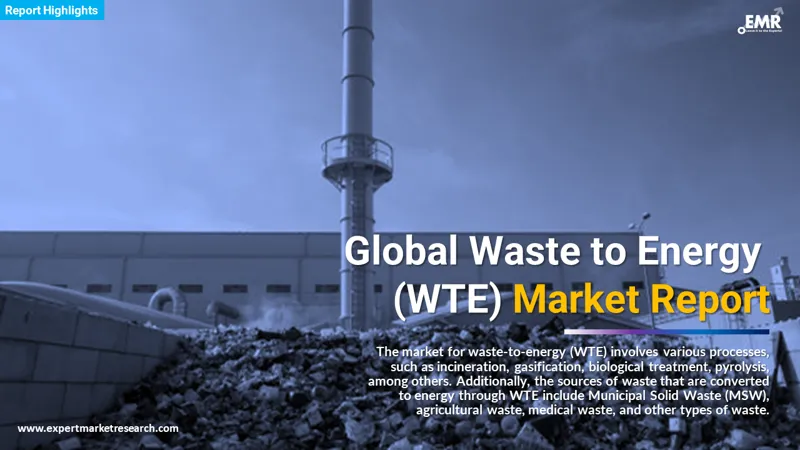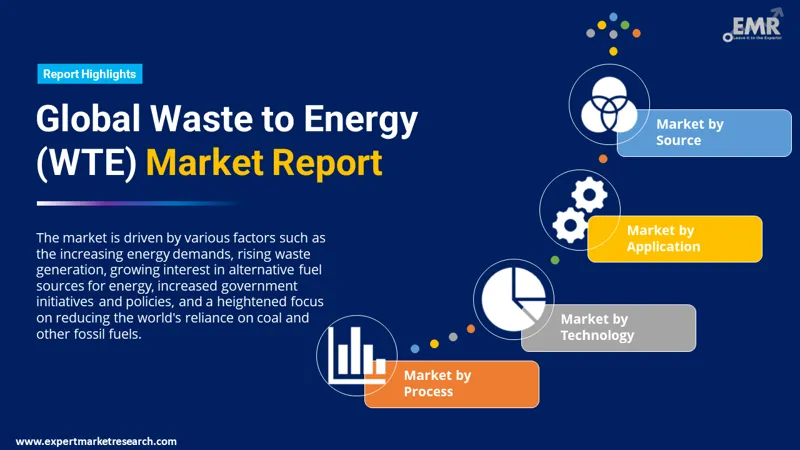
Consumer Insights
Uncover trends and behaviors shaping consumer choices today
Procurement Insights
Optimize your sourcing strategy with key market data
Industry Stats
Stay ahead with the latest trends and market analysis.
The global waste to energy (WTE) market value reached USD 60.24 Billion in 2025. During the forecast period of 2026 and 2035, the market is expected to grow at a CAGR of 10.70% to reach a value of around USD 166.48 Billion by 2035.
Base Year
Historical Period
Forecast Period
Compound Annual Growth Rate
10.7%
Value in USD Billion
2026-2035
*this image is indicative*
| Global Waste to Energy (WTE) Market Report Summary | Description | Value |
| Base Year | USD Billion | 2025 |
| Historical Period | USD Billion | 2019-2025 |
| Forecast Period | USD Billion | 2026-2035 |
| Market Size 2025 | USD Billion | 60.24 |
| Market Size 2035 | USD Billion | 166.48 |
| CAGR 2019-2025 | Percentage | XX% |
| CAGR 2026-2035 | Percentage | 10.70% |
| CAGR 2026-2035 - Market by Region | North America | 11.3% |
| CAGR 2026-2035 - Market by Country | UK | 11.5% |
| CAGR 2026-2035 - Market by Country | USA | 11.2% |
| CAGR 2026-2035 - Market by Process | Gasification | 11.7% |
| CAGR 2026-2035 - Market by Source | MSW (Municipal Solid Waste) | 11.4% |
| Market Share by Country 2025 | Canada | 2.6% |
Waste to energy is the process of transforming waste using thermochemical and biochemical processes to produce energy in the form of heat or electricity. It is also known as EFW (energy-from-waste). WTE technologies offer an energy security option in addition to a better method of waste disposal.
Over the forecast period, the waste to energy (WTE) industry growth is expected to be significantly influenced by favourable regulatory policies that encourage appropriate waste disposal, energy production, and rising energy demands from the end-use sector.

Read more about this report - REQUEST FREE SAMPLE COPY IN PDF
The waste to energy (WTE) market dynamics and trends are gaining momentum due to increasing waste production, heightened focus on effective waste management for sustainable urban living, and a growing interest in alternative energy sources.
Greater government initiatives and policies, coupled with a stronger emphasis on decreasing dependence on coal and other fossil fuels, are expected to further drive the demand of the waste to energy (WTE) market.
According to Seattle Public Utilities, the composition of municipal solid waste (MSW) in Seattle from 2018 to 2020 showed clear sectoral trends. The multifamily sector's MSW share notably increased from 23% in 2018 to 30% in 2020. The residential sector's share of MSW also grew, rising from 16% in both 2018 and 2019 to 19% in 2020. At the same time, self-haul municipal solid waste (MSW) stayed consistent, making up about 8% in 2018 and 2019, with a small increase to 9% in 2020. This rise contributes to the growth of the waste to energy (WTE) market revenue, which converts municipal solid waste into usable energy like electricity or heat using various technologies.
According to the New Hampshire Department of Environmental Services, total solid waste disposal in New Hampshire increased slightly from 1,956,789 tons in 2020 to 1,999,123 tons in 2021. Waste from in-state sources saw a notable rise, growing from 1,042,957 tons in 2020 to 1,121,263 tons in 2021, an increase of approximately 78,306 tons. This growth raised the proportion of in-state waste from 53% to 56%, indicating a heightened reliance on local waste generation and disposal capabilities.
According to the Central Pollution Control Board of Delhi, for the 2020-21 period, Delhi had the highest per capita waste generation in India, exceeding 450 grams per day. Lakshadweep and Mizoram followed closely, each generating around 400 grams per capita per day. Daman and Diu, Puducherry, and Telangana also showed high per capita waste generation, each surpassing 300 grams per day. Meanwhile, Haryana and Maharashtra produced between 200 and 250 grams of waste per capita per day. States such as Gujarat, Punjab, and West Bengal showed per capita waste generation ranging from 150 to 200 grams daily. Andhra Pradesh and Uttarakhand had lower rates, generating between 100 and 150 grams per capita per day. This variation in waste generation supports the growth of the waste to energy (WTE) industry revenue in India, driven by increasing waste production, a focus on sustainable waste management, and the push for alternative energy sources.
Veolia S.A.
Suez S.A.
Hitachi Zosen Inova AG
Keppel Seghers

Read more about this report - REQUEST FREE SAMPLE COPY IN PDF
“Global Waste to Energy (WTE) Market Report and Forecast 2026-2035” offers a detailed analysis of the market based on the following segments:
Market Breakup by Process
Market Breakup by Source
Market Breakup by Technology
Market Breakup by Application
Market Breakup by Region
| CAGR 2026-2035 - Market by | Country |
| UK | 11.5% |
| USA | 11.2% |
| India | 10.4% |
| Germany | 10.4% |
| Mexico | 10.2% |
| Canada | XX% |
| France | XX% |
| Italy | XX% |
| China | XX% |
| Japan | XX% |
| Australia | XX% |
| Saudi Arabia | 9.7% |
| Brazil | XX% |
In the waste to energy (WTE) market, fluidised beds are widely used technologies that mix fluid and solid particles to efficiently carry out various physical and chemical processes. They are employed in numerous applications, including the cracking and reforming of hydrocarbons, coal carbonization and gasification, ore roasting, waste combustion, and burning of solid, liquid, and gaseous fuels.
Rotary kilns, known for their versatility, are commonly used for incinerating solid and liquid waste. They heat materials to specific temperatures in a controlled environment to induce chemical or physical reactions, further boosting the growth of the waste to energy (WTE) market.
The company’s focus is on energy services, speciality insurance, and waste disposal. They also own and manage power generation and waste-to-energy projects.




*While we strive to always give you current and accurate information, the numbers depicted on the website are indicative and may differ from the actual numbers in the main report. At Expert Market Research, we aim to bring you the latest insights and trends in the market. Using our analyses and forecasts, stakeholders can understand the market dynamics, navigate challenges, and capitalize on opportunities to make data-driven strategic decisions.*
Get in touch with us for a customized solution tailored to your unique requirements and save upto 35%!
In 2025, the global market for waste to energy (WTE) attained a value of nearly USD 60.24 Billion.
The market is projected to grow at a CAGR of nearly 10.70% in the forecast period of 2026-2035.
The market is estimated to witness healthy growth in the forecast period of 2026-2035 to reach USD 166.48 Billion by 2035.
The major drivers of the market include rising energy demands, increasing waste creation, growing interest in alternative fuel sources for energy, increased government initiatives and policies, and heightened focus on reducing the world's reliance on coal and other fossil fuels.
Favourable regulatory policies and increased concern over waste management are the key industry trends propelling the growth of the market.
The market is broken down into North America, Europe, Asia Pacific, Latin America, the Middle East, and Africa.
The market is broken down into incineration, gasification, biological, and pyrolysis, and others.
The different sources of WTE are MSW (Municipal Solid Waste), agriculture waste, medical waste, and others.
Based on technology, the market is divided into fluidised bed and rotary kiln, among others.
The major applications of the market are heating, power generation, combined heat and power, and transport.
The competitive landscape consists of Veolia S.A., Suez S.A., Hitachi Zosen Inova AG, Keppel Seghers, Martin GmbH, China Everbright Environment Group Ltd, Jansen Combustion and Boiler, Grandblue Environment Co Ltd, Attero, and Covanta Holding Corporation, among others.
One of the most reliable and efficient forms of alternative energy for reducing CO2 emissions and displacing fossil fuels is waste to energy.
Waste-to-energy has drawbacks, many of which have surfaced in recent years. Its negative effects include the pollution and particulates it produces, the destruction of good materials, and the possibility that it will disincentivise the use of renewable energy and more environmentally friendly waste management techniques.
Explore our key highlights of the report and gain a concise overview of key findings, trends, and actionable insights that will empower your strategic decisions.
| REPORT FEATURES | DETAILS |
| Base Year | 2025 |
| Historical Period | 2019-2025 |
| Forecast Period | 2026-2035 |
| Scope of the Report |
Historical and Forecast Trends, Industry Drivers and Constraints, Historical and Forecast Market Analysis by Segment:
|
| Breakup by Process |
|
| Breakup by Source |
|
| Breakup by Technology |
|
| Breakup by Application |
|
| Breakup by Region |
|
| Market Dynamics |
|
| Competitive Landscape |
|
| Companies Covered |
|
Datasheet
One User
USD 2,499
USD 2,249
tax inclusive*
Single User License
One User
USD 3,999
USD 3,599
tax inclusive*
Five User License
Five User
USD 4,999
USD 4,249
tax inclusive*
Corporate License
Unlimited Users
USD 5,999
USD 5,099
tax inclusive*
*Please note that the prices mentioned below are starting prices for each bundle type. Kindly contact our team for further details.*
Flash Bundle
Small Business Bundle
Growth Bundle
Enterprise Bundle
*Please note that the prices mentioned below are starting prices for each bundle type. Kindly contact our team for further details.*
Flash Bundle
Number of Reports: 3
20%
tax inclusive*
Small Business Bundle
Number of Reports: 5
25%
tax inclusive*
Growth Bundle
Number of Reports: 8
30%
tax inclusive*
Enterprise Bundle
Number of Reports: 10
35%
tax inclusive*
How To Order

Select License Type
Choose the right license for your needs and access rights.

Click on ‘Buy Now’
Add the report to your cart with one click and proceed to register.

Select Mode of Payment
Choose a payment option for a secure checkout. You will be redirected accordingly.
Gain insights to stay ahead and seize opportunities.

Get insights & trends for a competitive edge.

Track prices with detailed trend reports.

Analyse trade data for supply chain insights.

Leverage cost reports for smart savings

Enhance supply chain with partnerships.

Connect For More Information
Our expert team of analysts will offer full support and resolve any queries regarding the report, before and after the purchase.
Our expert team of analysts will offer full support and resolve any queries regarding the report, before and after the purchase.
We employ meticulous research methods, blending advanced analytics and expert insights to deliver accurate, actionable industry intelligence, staying ahead of competitors.
Our skilled analysts offer unparalleled competitive advantage with detailed insights on current and emerging markets, ensuring your strategic edge.
We offer an in-depth yet simplified presentation of industry insights and analysis to meet your specific requirements effectively.
Share